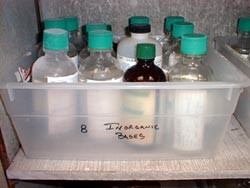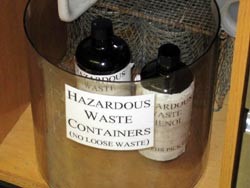The improper handling of chemical waste can result in injuries to employees, damage to the environment, and fines from regulatory agencies. Hazardous waste containers must comply with EPA regulations.
The container must be labeled "Hazardous Waste", dated on the day that waste is first accumulated, and have the constituents of the container spelled out in full, in English. At the end of the workday or experiment, be sure that any funnel that collects waste into a container is taken out of the container and the container recapped.
See the guidelines on labeling containers and prefilled Chemical Waste Labels under Hazardous Material Management.
Storage of hazardous chemicals for speculative use is not permitted. Itemize chemicals to be removed and submit the list to EHS for a chemical waste pickup.
It is the responsibility of laboratory custodians to ensure that containers of hazardous waste stored in the laboratories under their control are managed properly.
To ensure proper management of these containers, follow these guidelines:
- All hazardous waste designated for disposal must be placed in appropriate glass, metal, or chemically inert, non-reactive, non-flexible plastic containers with tightly fitting screw caps. Corrosives should not be placed in metal containers. Leaking, visibly damaged, or rusted containers are not acceptable. Used containers should be clean. Do not refill used reagent containers with potentially incompatible waste chemicals. Open containers or containers with cut glass, aluminum foil, Parafilm, rubber, or cork stoppers are unacceptable. Do not overfill waste containers.
- All containers labeled as containing hazardous waste must be stored in a secondary containment device (i.e., tub or basin) to prevent environmental contamination in the event of a spill or leaking container. Each basin must be leakproof and constructed of chemically inert material. It must be capable of containing either the total volume of the largest waste container in the basin or 10 percent of the total waste volume in the basin, whichever is greater.
- The exterior of each waste container must be clean and free from chemical contamination so that labels will adhere to the container. All markings not pertaining to the actual waste contents must be completely removed or obliterated.
- Waste containers must be kept closed at all times except when in the process of adding waste to the container. Waste containers must not be filled to the top. Two inches of space must be left at the top of every container larger than a quart.
- Waste containers must be inspected weekly for leaks and/or deterioration. If a container is leaking or deteriorating, transfer its contents to a new, suitable container.
Chemical containers that have been emptied (generally this means drained of their contents by normal means including pouring, pumping, aspirating, etc.) are not regulated as hazardous waste; however, they should be triple-rinsed with water or other suitable solvent and air-dried to ensure that they are free of liquid or other visible chemical residues. Additionally, all labels identifying the contents of the container should be removed or defaced. Containers meeting these criteria should either be placed into a broken glass container or the general refuse containers provided by General Services. The generator must determine whether the washings must be collected and disposed of as hazardous waste. For volatile organic solvents (acetone, ethanol, ethyl acetate, ethyl ether, hexane, methanol, petroleum ether, toluene, xylene, etc.) not on the list of acutely hazardous wastes (P-List), the empty container can be air-dried in a ventilated area (e.g., chemical fume hood) without triple-rinsing.
If residues remain after, the container should be disposed of as chemically contaminated solid waste and consigned to EHS for disposal.
Common findings relevant to chemical waste containers:
Not labeled "Hazardous Waste":
All containers used for the collection of hazardous wastes must be labeled with the words "Hazardous Waste".
Not labeled with constituents and date:
All containers used for the collection of hazardous wastes must be labeled with the chemical names, spelled out in English, of all components and dated from the day of first accumulation. Chemical abbreviations, formulas, and structures are not acceptable. In addition, all constituents of a solution must be broken down and listed by percentage.
Chemical container management issues identified/containers in poor condition:
All chemical containers must be in good condition with no visible damage or deterioration. Caps must be secure, intact, and without chemical residue. Labels must be intact and fully legible. Any container found to be leaking, rusted, or forming precipitates must be disposed of immediately as chemical waste.
Chemical waste containers open or unsealed:
Tight-fitting lids are required on all chemical containers. Funnels remaining in the containers, corks with holes, aluminum foil, and Parafilm are examples of unacceptable lids.
Chemical waste not stored in secondary containment:
All containers storing liquid chemical waste require secondary containment, such as a plastic tub capable of containing the contents in the event of breakage or leakage.
Good examples of secondary containment:




